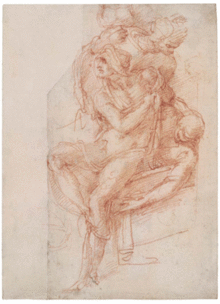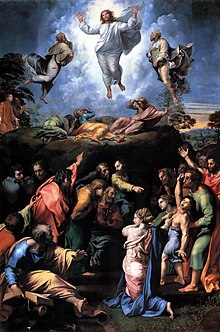The Raising of Lazarus (Sebastiano del Piombo)
The Raising of Lazarus is a large altarpiece of 1517–1519 by the Italian High Renaissance artist Sebastiano del Piombo, for which Michelangelo supplied drawings for some figures.
[6] Lazarus's resurrection from the dead was the most frequently depicted of the miracles of Jesus in medieval and Renaissance art, as both the most remarkable and the easiest to recognize visually, because of the grave-cloths.
The standing female in orange is Martha of Bethany, sister of Lazarus and Mary; in the gospel, before the tomb is opened, she protests that the body will smell, and her gesture suggests she was right.
By this stage of the High Renaissance, not even Christ is given a halo, making it harder to pick out any specific individuals from the crowd that the gospel account mentions.
Michael Levey said the painting was "full of obvious portrait heads",[3] but there has been much much less speculation as to the individuals with inserted likenesses than for Raphael's The School of Athens of a few years earlier.
[16] The painting was begun some five years after Sebastiano had moved from his native Venice to Rome, and shows that his adaption to a monumental and classical Roman style was effectively complete, though the colours "retain a Venice-like luminosity that enchants the eye".
[4] Vasari, who knew both artists in later years, described the collaboration by saying that the picture was made "sotto ordine e disegno in alcune parti" of Michelangelo, rather vague phrasing that has been much discussed.
He died the following year, and the replica replacement promised as part of the purchase was eventually sent around 1750; it was probably by Charles-André van Loo and still hangs in the cathedral.
[36] Sebastiano evidently prevailed, as below the replica in Narbonne the altar still has part of a "sophisticated" frame in gold on blue that carries above the two festoons the Medici impresa of a diamond ring with feathers rising through it, and the motto SEMPER ("always"), and is presumed to be from Rome.
[37] Probably in 1771, Sebastiano's painting was transferred from wooden panel to canvas and some of the pigments have as a result lost their brightness, most notably the red of Christ's robe, which has turned pink.
[38] No doubt because it soon left Rome for the artistic backwater of Narbonne, the earliest print of the painting was remarkably late, in an illustrated account of the Orleans Collection, published in 1786 on the eve of its dispersal.
In one of the auction sales dedicated to the collection beginning on 26 December 1798 The Raising of Lazarus was bought by the London banker John Julius Angerstein, apparently at the urging of Sir Thomas Lawrence.
[43] In the exhibition Michelangelo & Sebastiano at the National Gallery (ended 25 June 2017) it was shown together with several of the preparatory drawings for it by both artists, and letters between them.
For the exhibition the National Gallery gave the painting a permanent new frame, with the bottom copying the original element still in Narbonne Cathedral.
According to the National Gallery's detailed account of the restoration history and current condition of the painting: "There can be little doubt that this drastic and dangerous intervention was totally unnecessary".
Much damage to the painting seems to have resulted, and the connoisseur and art theorist Richard Payne Knight wrote that "those who have only seen it since that fatal operation ... can form but very imperfect notions of what it was before".
[45] In the 1820s the artist Benjamin West, the painting's "most vocal admirer", is recorded as restoring and repainting damaged areas on Lazarus' right leg.
[46] The plan was changed to add layers of warm wax-resin in which an inert synthetic textile was fixed, before attaching to a composite board and paper honeycomb solid support.





